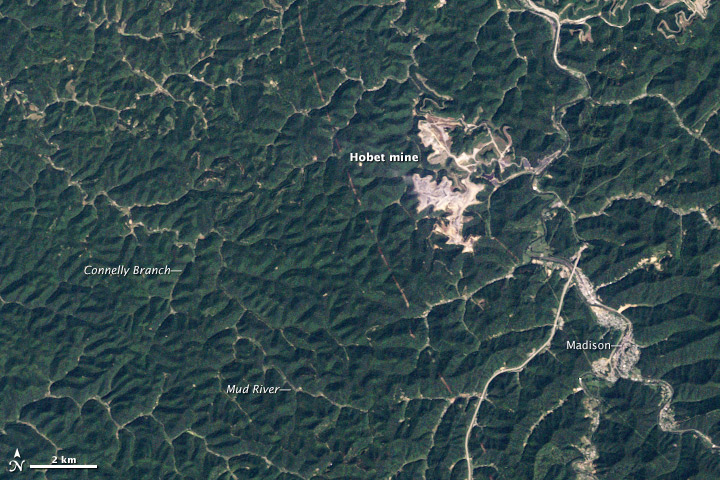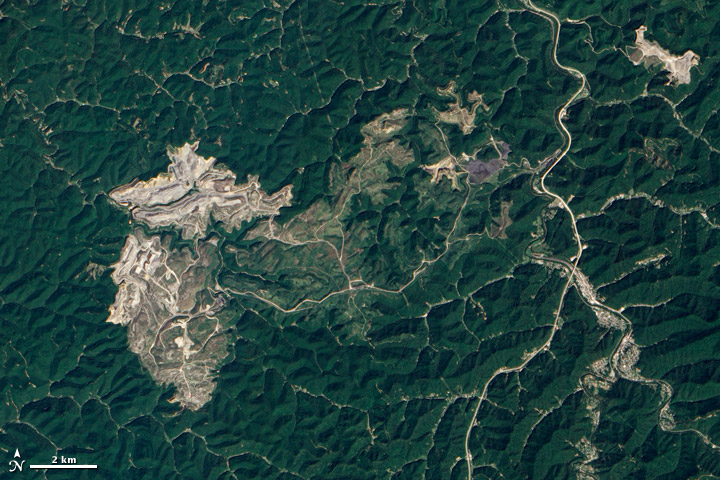Externalities are the costs that are not incurred by coal mining operations, hydraulic fracturing (fracking), and oil sands extraction. Aside from the fossil fuel emissions from the burning of coal, oil, and natural gas for power generation, the extraction process bears huge costs that most of us are willing to overlook for the short-term economic benefits. If you happen to be in the vicinity of a mine, however, you probably are paying close attention to everything the company in charge is doing. One impact is land-use, and unfortunately for companies tearing into relatively remote regions of the Earth to feed our massive hunger to consume, NASA has some excellent Earth observing satellites. Satellites have been high above Earth since the 1970s and this is one image of a region in West Virginia, USA in 1984  with another image of the same region in 2012
with another image of the same region in 2012  What do scientists do with this kind of imagery? Well, here is a the link to an amazingly clear image-animation of the process of removing a mountaintop in Appalachia (West Virginia, in this case) to uncover the coal. Related to the documentation of the mountaintop removal, is an image-animation of the land-use associated with the tar sands/oil sands extraction from Alberta’s boreal forest. Fracking doesn’t have as long a record, so NASA imagery doesn’t capture the results of this form of land-use. But states in the USA (including North Carolina) are lining up legislation to begin issuing permits for fracking. Proponents cite job creation and reduced greenhouse gas emissions (noting an important caveat to the 2nd point). Critics cite major concerns about just how long those economic gains will keep rolling in before locals are left with an environmental mess to clean up without help from the deep industrial pockets that created the mess.
What do scientists do with this kind of imagery? Well, here is a the link to an amazingly clear image-animation of the process of removing a mountaintop in Appalachia (West Virginia, in this case) to uncover the coal. Related to the documentation of the mountaintop removal, is an image-animation of the land-use associated with the tar sands/oil sands extraction from Alberta’s boreal forest. Fracking doesn’t have as long a record, so NASA imagery doesn’t capture the results of this form of land-use. But states in the USA (including North Carolina) are lining up legislation to begin issuing permits for fracking. Proponents cite job creation and reduced greenhouse gas emissions (noting an important caveat to the 2nd point). Critics cite major concerns about just how long those economic gains will keep rolling in before locals are left with an environmental mess to clean up without help from the deep industrial pockets that created the mess.
carbon
Land use in action
Policy leadership on issues related to global warming
President Obama continues to steam ahead in the beginning of his 2nd term. His State of the Union speech was really well-done, and followed on the tone he set in his Inaugural Address. Not all of the speech was about climate (full transcript), but it is clear that even in the face of sequestration, if you are concerned about the impacts of global warming, then now is the time to send a letter to your representative, senator, and even our president to let them know you support the forward-thinking policy. Here is a snippet of the part of the speech most relevant to addressing the impacts of global warming. I added links to points that verify or provide a more complete perspective on statements President Obama made.
Today, no area holds more promise than our investments in American energy. After years of talking about it, we’re finally poised to control our own energy future. We produce more oil at home than we have in 15 years. We have doubled the distance our cars will go on a gallon of gas and the amount of renewable energy we generate from sources like wind and solar, with tens of thousands of good, American jobs to show for it. We produce more natural gas than ever before, and nearly everyone’s energy bill is lower because of it. And over the last four years, our emissions of the dangerous carbon pollution that threatens our planet have actually fallen. But for the sake of our children and our future, we must do more to combat climate change.
Now, it’s true that no single event makes a trend. But the fact is, the 12 hottest years on record have all come in the last 15. Heat waves, droughts, wildfires, floods, all are now more frequent and more intense. We can choose to believe that Superstorm Sandy, and the most severe drought in decades, and the worst wildfires some states have ever seen were all just a freak coincidence. Or we can choose to believe in the overwhelming judgment of science and act before it’s too late.
Now, the good news is, we can make meaningful progress on this issue while driving strong economic growth. I urge this Congress to get together, pursue a bipartisan, market-based solution to climate change, like the one John McCain and Joe Lieberman worked on together a few years ago. But if Congress won’t act soon to protect future generations, I will. I will direct my cabinet to come up with executive actions we can take, now and in the future, to reduce pollution, prepare our communities for the consequences of climate change, and speed the transition to more sustainable sources of energy.
Now, four years ago, other countries dominated the clean-energy market and the jobs that came with it. And we’ve begun to change that. Last year, wind energy added nearly half of all new power capacity in America. So let’s generate even more. Solar energy gets cheaper by the year. Let’s drive down costs even further. As long as countries like China keep going all-in on clean energy, so must we.
Now, in the meantime, the natural gas boom has led to cleaner power and greater energy independence. We need to encourage that. That’s why my administration will keep cutting red tape and speeding up new oil and gas permits. That’s got to be part of an all-of-the-above plan. But I also want to work with this Congress to encourage the research and technology that helps natural gas burn even cleaner and protects our air and our water. In fact, much of our newfound energy is drawn from lands and waters that we, the public, own together. So tonight, I propose we use some of our oil and gas revenues to fund an Energy Security Trust that will drive new research and technology to shift our cars and trucks off oil for good. If a nonpartisan coalition of CEOs and retired generals and admirals can get behind this idea, then so can we. Let’s take their advice and free our families and businesses from the painful spikes in gas prices we’ve put up with for far too long. I’m also issuing a new goal for America: Let’s cut in half the energy wasted by our homes and businesses over the next 20 years.
I do feel like this part of his speech does make some concessions and perhaps side steps the simple fact that the USA has to lead a GLOBAL effort to eliminate carbon emissions. This does not mean using natural gas instead of coal in the USA is a good thing because coal is still being mined and sent elsewhere (Europe) and the long-term health/environmental costs on top of the costs of more carbon in the atmosphere (natural gas combustion still releases carbon even if it’s less than coal – good article here) are a powerful part of that equation that essentially are being neglected for the economy. Policy might simply be lagging the science, but the science is becoming more and more stark, while policy suffered from years of delay when action was needed. I know climate is not the only issue on the table, but it is the clearest issue when trying to understand the future. Every year we delay will make any level of action not only more difficult economically, but will also reduce the impact of that action.
Where the US coal is going
Many in North Carolina are aware of the move in the energy industry from coal to natural gas (example 1, and others from photos with telling captions at example 2, example 3, example 4, etc.). Fracking has opened up a huge reserve of natural gas, driving down consumer costs and keeping the individual happy while essentially ignoring the larger health and environmental costs to society down the line. Leave that part alone and focus on coal. The US mines coal, but what is the incentive for continued mining? Certainly it is not for the sake of communities and ecosystem as discussed in another sobering study about the true costs of a very dirty form of energy. Glancing at the Washington Post this morning reveals why coal is still being mined in the US, and hints about why there is no monetary incentive to slow frakking in the US. Here’s the article. One part of the article says
Europe’s use of the fossil fuel spiked last year after a long decline, powered by a surge of cheap U.S. coal on global markets and by the unintended consequences of ambitious climate policies that capped emissions and reduced reliance on nuclear energy.
This is a worrying development that is happening in response to two things: 1. US fracking for natural gas driving down US coal prices and 2. A country that shuts down old nuclear plants in response to the disaster in Japan. Neither 1 or 2 by itself is a problem, but the far-reaching impacts of violently tearing into the world are something are completely ignored by industries and by the consumers that demand low-cost energy sources. Economics is trumping common sense. Another quote from the articles is
Demand for coal in Germany has been rising since a May 2011 move to phase out nuclear power by 2022. The shutdown was spurred by the nuclear meltdown at the Fukushima Daiichi plant in Japan as well as long-standing German concerns about safety. But nuclear energy, which is low in greenhouse gas emissions, has been partially replaced by brown coal. Lignite supplied 25.6 percent of Germany’s electricity in 2012, up from 22.7 percent in 2010. Hard black coal supplied an additional 19.1 percent last year, and it was also on the rise.
The economy will likely improve (in the US and Europe in the case of the Washington Post article), and as the article points out, US carbon emissions from electricity generation are down to 1992 levels, but my studies of the climate system as I prepare for teaching reveal that this is likely a short-term benefit with long-term costs. Global warming is still global, and global carbon emissions are what matter. Global carbon emissions continue to increase, as described in this source. Google ‘global carbon emissions’ for many more groups tracking or discussing carbon. The simple evidence suggests that carbon-based energy is nowhere close to leaving the scene.